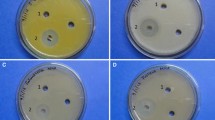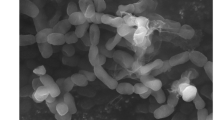Abstract
Forty marine actinobacteria were isolated from the sediments of east coast (Bay of Bengal) region of Tamilnadu, India. Morphologically distinct colonies were primarily tested against fish pathogenic bacteria such as Vibrio cholerae, V. parahaemolyticus, V. alginolyticus, Pseudomonas fluorescens and Aeromonas hydrophila by cross-streak plate method. The secondary metabolites produced by the highly potential strain cultured on starch casein broth were extracted separately with various solvents such as alcohol, ethyl acetate, methanol, petroleum ether and chloroform. The antibacterial assay of the bioactive compounds was tested against the fish pathogenic bacteria by well diffusion method. Of the various solvents used, the ethyl acetate extract of the isolate had good antibacterial activity. The potential strain was identified as Streptomyces labedae by phenotypic, 16S rRNA gene sequence and phylogenetic analysis. Purification of the biologically active compounds by column chromatography led to isolation of 27 fractions. The biologically active fraction was re-chromatographed on a silica gel column to obtain a single active compound, namely N-isopentyltridecanamide. The structure of the compounds was elucidated on the basis of ultra violet, Fourier transform infrared and nuclear magnetic resonance spectra.






Similar content being viewed by others
References
Atta HS, Dabour M, Desoukey SG (2009) Sparsomycin antibiotic production by Streptomyces sp. AZ-NIOFDI: taxonomy, fermentation, purification and biological activities. Am-Eur J Agric Environ Sci 5(3):368–377
Baskaran R, Vijayakumar R, Mohan PM (2011) Enrichment method for the isolation of bioactive actinomycetes from mangrove sediments of Andaman islands, India. Malays J Microbiol 7(1):26–32
Boone KE, Pine L (1968) Rapid method for characterization of actinomycetes by cell wall composition. Appl Microbiol 16:279–284
Chatterjee S, Haldar S (2012) Vibrio related diseases in aquaculture and development of rapid and accurate identification methods. J Marine Sci Res Dev S1:1–7
Cholarajan A, Vijayakumar R (2013) Isolation, identification, characterization and screening of antibiotic producing actinobacteria from the crop field of Thanjavur district, Tamilnadu, India. Int J Recent Sci Res 4(1):55–60
Dhanasekaran D, Panneerselvam A, Thajuddin N (2008) An antifungal compound: 4′ phenyl-1-napthyl–phenyl acetamide from Streptomyces spp. DPTB16. Facta Universitatis. Med Biol 15(1):7–12
Egorov NS (1985) Antibiotics, a scientific approach. Mir Publishers, Moscow
Feigl F (1960) Spot tests in organic analysis, 6th edn. Elsevier Publishing Company, London
FAO (2010) The state of the world fisheries and aquaculture. Food and Agriculture Organization of the United Nations, Rome
Haldar S, Mody KH, Jha B (2011) Abundance, diversity and antibiotic resistance pattern of Vibrio spp. in coral ecosystem of Kurusadai island. J Basic Microbiol 51:153–162
Hall TA (1999) A user-friendly biological sequence alignment editor and analysis program for Windows 95/98/NT. Nucl Acids Symp Ser 41:95–98
Holt JG, Krieg NR, Sneath PHA, Stanley JT, Williams ST (1994) Bergey’s manual of determinative bacteriology, 9th edn. Williams & Wilkins, Baltimore, pp 571–701
Janardhan A, Praveen Kumar A, Viswanath B, Saigopal DVR, Narasimha G (2014) Production of bioactive compounds by actinomycetes and their antioxidant properties. Biotechnol Res Int. doi:10.1155/217030
Kavitha A, Prabhakar P, Vijayalakshmi M, Venkateswarlu Y (2010) Purification and biological evaluation of the metabolites produced by Streptomyces sp. TK-VL_333. Res Microbiol 161(5):335–345
Nedialkova D, Mariana N (2005) Screening the antimicrobial activity of actinomycetes strains isolated from Antarctica. J Cult Collect 4(1):29–35
Parthasarathi S, Sathya S, Bupesh G, Duraisamy R, Ram Mohan M, Selva Kumar G, Manikandan M, Kim CJ, Balakrishnan K (2012) Isolation and characterization of antimicrobial compound from marine Streptomyces hygroscopicus BDUS 49. World J Fish Mar Sci 4(3):268–277
Prasad P, Singh T, Bedi S, Kumari S (2013) Molecular characterization and phylogenetic analysis of cellulase producing Streptomyces griseorubens (strain st-1) isolated from Indian soil. Jordan J Biol Sci 6(3):239–242
Premanand T, Chellaram C, Kumaran S, Shanthini FC (2011) Screening for antibiotic producing marine bacteria against fish pathogens. Int J Pharma Biosci 2(1):B314–B325
Pridham TG, Tresner HD (1974) Streptomycetaceae. In: Buchanan RE, Gibbons NE (eds) Bergey’s manual of determinative bacteriology, 8th edn. Williams and Wilkins, Baltimore, pp 748–829
Pugazhvendan SR, Kumaran S, Alagappan KM, Guruprasad S (2010) Inhibition of fish bacterial pathogens by antagonistic marine actinomycetes. Eur J Appl Sci 2(2):4–43
Ramesh S, Rajesh M, Mathivanan N (2009) Characterization of a thermo stable alkaline protease produced by marine Streptomyces fungicides MML1614. Bioprocess Biosyst Eng 32(6):791–800
Ravel J, Amoroso MJ, Colwell RR, Hill RT (1998) Mercury-resistant actinomycetes from the Chesapeake Bay. FEMS Microbiol Lett 162(1):177–184
Remya M, Vijayakumar R (2008) Isolation and characterization of marine antagonistic actinomycetes from west coast of India. Facta Universitatis Med Biol 15(1):13–19
Saitou N, Nei M (1987) The neighbour joining method: a new method for reconstructing phylogenetic trees from evolutionary distance data. Mol Biol Evol 4:406–425
Sathiyaseelan K, Stella D (2011) Isolation, identification and antagonistic activity of marine actinomycetes isolated from the Muthupet mangrove environment. Int J Pharm Biol Arch 2(5):1464–1468
Selvameenal L, Radhakrishnan M, Balagurunathan R (2009) Antibiotic pigment from desert soil actinomycetes; biological activity, purification and chemical screening. Indian J Pharm Sci 71(5):499–504
Subasinghe RP, Bondad-Reantaso MG, McGladdery SE (2001) Aquaculture development, health and wealth. In: Subasinghe RP, Bueno P, Phillips MJ, Hough C, McGladdery SE, Arthur JR (eds) Technical proceedings of the conference on aquaculture in the third millennium, Feb 2000. Bangkok, Thailand, pp 167–191
Thirumurugan D, Vijayakumar R (2013) A potent fish pathogenic bacterial killer Streptomyces sp. isolated from the soils of east coast region, South India. J Coastal Life Medicine 1(3):175–180
Thomas PM (1975) Organic chemistry. S. Chand and Co., New Delhi
Tian SZ, Pu X, Luo G, Zhao LX, Xu LH, Li WJ, Luo Y (2013) Isolation and characterization of new p-Terphenyls with antifungal, antibacterial, and antioxidant activities from halophilic actinomycete Nocardiopsis gilva YIM 90087. J Agric Food Chem 61(12):3006–3012
Vaijayanthi G, Cholarajan A, Vijayakumar R (2012) Isolation, characterization and antibacterial activity of terrestrial actinobacteria in the soils of Thanjavur district, Tamilnadu, India. Res J Sci Tech 4(3):132–139
Valli S, Sugasini S, Aysha OS, Nirmala P, Vinoth Kumar P, Reena A (2012) Antimicrobial potential of actinomycetes species isolated from marine environment. Asian Pac J Trop Biomed 2(6):469–473
Vijayakumar R, Muthukumar C, Thajuddin N, Panneerselvam A, Saravanamuthu R (2007) Studies on the diversity of actinomycetes in the palk strait region of Bay of Bengal, India. Actinomycetologica 21(2):59–65
Vijayakumar R, Panneerselvam K, Muthukumar C, Thajuddin N, Panneerselvam A, Saravanamuthu R (2012) Optimization of antimicrobial production by a marine actinomycete Streptomyces afghaniensis VPTS3-1 isolated from Palk Strait, east coast of India. Indian J Microbiol 52(2):230–239
Vijayalakshmi M, Sujatha S, Kavitha A (2011) Isolation, identification and antibacterial profile of two marine actinobacteria. J Pharm Res 4(7):2317–2321
Vogel IA (1971) A text-book of practical organic chemistry. ELBS, London
Waksman SA, Henrici AT (1943) The nomenclature and classification of the actinomycetes. J Bacteriol 46:337–341
Wilson K (1990) Preparation of genomic DNA from bacteria. In: Ausubel Kingston RE, Moore DD, Smith JA, Seidman JG, Struhl K (eds) Current protocol in molecular biology, Chapter 2–4. Greene publishing and Wiley Inter Science, New York, pp 99–171
Acknowledgments
The authors are thankful to Bharathidasan University, India and the Management of SRM University, India for providing necessary facilities.
Conflict of interest
The authors declare that they have no conflict of interest.
Author information
Authors and Affiliations
Corresponding author
Rights and permissions
About this article
Cite this article
Thirumurugan, D., Vijayakumar, R. Characterization and Structure Elucidation of Antibacterial Compound of Streptomyces sp. ECR77 Isolated from East Coast of India. Curr Microbiol 70, 745–755 (2015). https://doi.org/10.1007/s00284-015-0780-3
Received:
Accepted:
Published:
Issue Date:
DOI: https://doi.org/10.1007/s00284-015-0780-3




